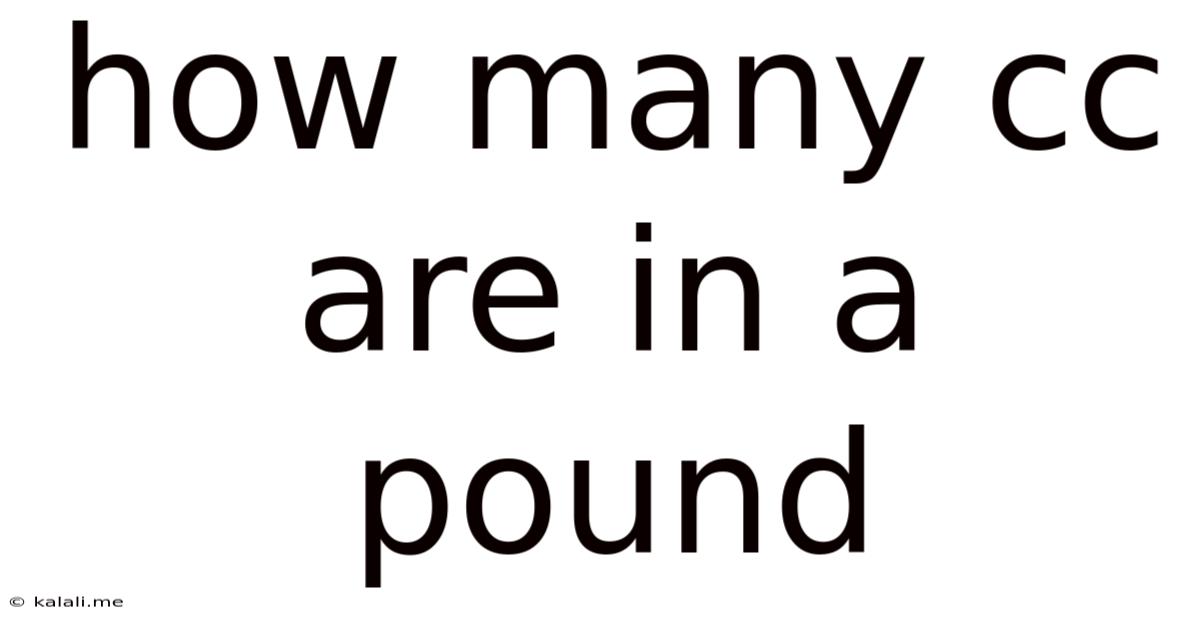How Many Cc Are In A Pound
Kalali
Jul 27, 2025 · 4 min read

Table of Contents
How Many CCs Are in a Pound? Understanding Volume and Weight Conversions
This question, "How many cc's are in a pound?", highlights a common confusion between volume (cubic centimeters, or cc) and weight (pounds). They're fundamentally different measurements and cannot be directly converted without knowing the density of the substance in question. This article will delve into the complexities of this conversion, exploring the relationship between volume and weight, explaining the crucial role of density, and providing practical examples and calculations to help you understand this concept thoroughly.
Meta Description: Learn how to convert pounds to cubic centimeters. This comprehensive guide explains the crucial role of density in converting weight to volume, providing examples and formulas for accurate calculations. Understand the difference between weight and volume measurements.
The Fundamental Difference: Weight vs. Volume
Before diving into the conversion, it's vital to understand the difference between weight and volume.
-
Weight: A measure of the force of gravity on an object. It's expressed in units like pounds (lbs), kilograms (kg), grams (g), etc. Weight can change depending on the gravitational pull (e.g., you weigh less on the moon).
-
Volume: A measure of the three-dimensional space occupied by an object. It's expressed in units like cubic centimeters (cc or cm³), liters (L), cubic meters (m³), gallons (gal), etc. Volume remains constant regardless of location.
Because weight is affected by gravity while volume is not, a direct conversion isn't possible. A pound of feathers and a pound of lead have the same weight but vastly different volumes. This difference stems from their density.
Density: The Key to Conversion
Density is the mass of a substance per unit volume. It's the missing link that allows us to convert between weight and volume. The formula for density is:
Density = Mass / Volume
Or, rearranging the formula to solve for volume:
Volume = Mass / Density
This formula is the foundation of our conversion. We need the mass (in grams, since cc is a metric unit) and the density of the substance to calculate the volume in cubic centimeters.
Converting Pounds to Grams
First, we must convert pounds to grams. There are approximately 453.592 grams in one pound. Therefore:
Grams = Pounds * 453.592
Examples: Converting Pounds to Cubic Centimeters for Different Substances
Let's illustrate this with examples for different substances with varying densities.
Example 1: Water
Water has a density of approximately 1 gram per cubic centimeter (g/cm³). This makes the calculation straightforward.
Let's say we have 1 pound of water.
- Convert pounds to grams: 1 lb * 453.592 g/lb = 453.592 g
- Calculate volume: 453.592 g / 1 g/cm³ = 453.592 cm³
Therefore, 1 pound of water occupies approximately 453.6 cubic centimeters.
Example 2: Aluminum
Aluminum has a density of approximately 2.7 g/cm³. Let's calculate the volume of 1 pound of aluminum.
- Convert pounds to grams: 1 lb * 453.592 g/lb = 453.592 g
- Calculate volume: 453.592 g / 2.7 g/cm³ ≈ 168 cm³
Therefore, 1 pound of aluminum occupies approximately 168 cubic centimeters. Notice the significant difference in volume compared to water, even though both weigh 1 pound.
Example 3: Gold
Gold is much denser than water or aluminum, with a density of approximately 19.3 g/cm³. Let's see how this impacts the volume of 1 pound of gold.
- Convert pounds to grams: 1 lb * 453.592 g/lb = 453.592 g
- Calculate volume: 453.592 g / 19.3 g/cm³ ≈ 23.5 cm³
One pound of gold occupies only approximately 23.5 cubic centimeters, a much smaller volume due to its high density.
The Importance of Knowing the Substance
These examples clearly demonstrate the crucial role of density in converting pounds to cubic centimeters. Without knowing the density of the substance, the conversion is impossible. The same weight can occupy drastically different volumes depending on the material.
Practical Applications
Understanding this conversion is crucial in various fields:
-
Engineering: Designing containers, pipelines, and other structures requires accurate volume calculations based on the weight and density of the materials involved.
-
Manufacturing: Determining the amount of raw material needed for production processes necessitates accurate conversions between weight and volume.
-
Chemistry and Physics: Many experiments and calculations in these fields rely on precise measurements of both mass and volume.
-
Shipping and Logistics: Calculating shipping costs and determining the appropriate container sizes often involves conversions between weight and volume.
Conclusion: No Single Answer
There's no single answer to "How many cc's are in a pound?". The conversion depends entirely on the density of the substance. This article provides a thorough explanation of the process, highlighting the importance of density and providing practical examples to aid understanding. Remember to always consult a density table for accurate conversions, and use the formula: Volume = Mass / Density to perform the calculation. By understanding this fundamental relationship between weight and volume, you can navigate the world of measurements with greater accuracy and confidence.
Latest Posts
Latest Posts
-
How Much Is 10000 Hours In Days
Jul 27, 2025
-
How Far Is Tempe Az From Phoenix
Jul 27, 2025
-
How Many Years Ago Was 2000 Bc
Jul 27, 2025
-
How Many Feathers Are In A Pound
Jul 27, 2025
-
6 Times The Square Root Of 2
Jul 27, 2025
Related Post
Thank you for visiting our website which covers about How Many Cc Are In A Pound . We hope the information provided has been useful to you. Feel free to contact us if you have any questions or need further assistance. See you next time and don't miss to bookmark.